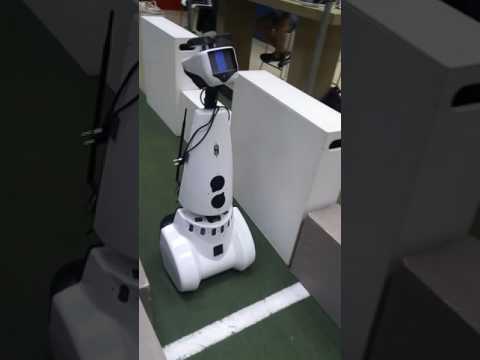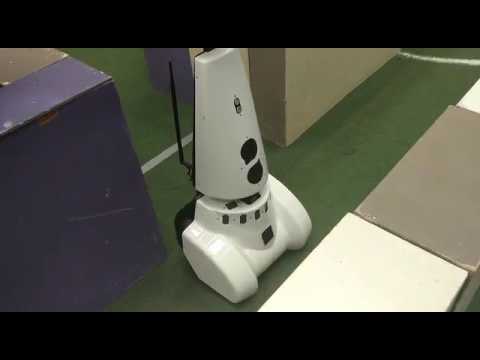Embedded Motion Control 2017 Group 5
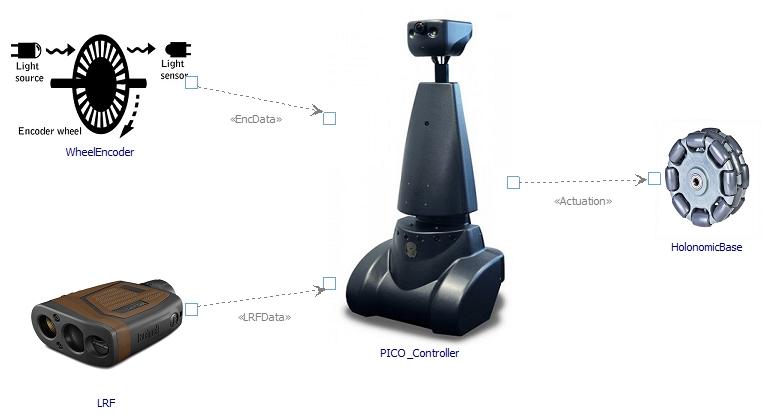
This page describes the development of the PICO maze controller for the course 4SC020 Embedded Motion Control. The objective of the project is to design a controller for PICO, a mobile robot equipped with a holonomic base, wheel encoders and a laser range finder (LRF). This controller shall enable PICO to autonomously navigate through a random maze without bumping into walls. The designed system receives data from the wheel encoders and the LRF which is then used to decide what movement commands will be the base.
Members Group 5
| Name | Student ID | |
| Torben Beernaert | 0778690 | t.f.beernaert@student.tue.nl |
| Rodrigo Estrella Treviño | 1035228 | r.estrella.trevino@student.tue.nl |
| Kagan Incetan | 1037760 | k.incetan@student.tue.nl |
| Sjoerd Knippenberg | 0738104 | s.c.m.knippenberg@student.tue.nl |
| Angel Molina Acosta | 1036456 | a.molina.acosta@student.tue.nl |
| Bart Vercoulen | 0747283 | b.c.g.vercoulen@student.tue.nl |
Requirements & Specifications
The requirements for the system are deducted from the course page and established from a brainstorm session. The FURPS model is used to group the requirements together in the following aspects:
- Functionality
- Usability
- Reliability
- Performance
- Supportability
A complete list of all requirements can be found in the requirements and specification overview.
Design
This chapter describes the design of the PICO controller. It revolves mainly around the final design implementations, but also elaborates on several functions that have remained unused and states evaluations and thoughts about the development of certain features.
Initial Design
The Initial Design document can be found here: Initial_Design_Group5.
Maze-solving Algorithms
Three maze solving algorithms are considered. These are elaborated in the upcoming sections, followed by a comparison and elaborate selection.
Wall follower
This algorithm is very simple to implement since only one rule applies: Follow the wall on either your left or right side (depending on the setting). This wall will be tracked until eventually, an exit is found. The algorithm is guaranteed to work when the robot starts at the entrance of a maze. However, if PICO starts at an arbitrary position it might get stuck in a loop, keeping track of the walls of an ‘island’. Since the case description states that the robot will be start from an arbitrary position and that the maze will contain a loop, this algorithm is risky to use and might not be able to guide the robot to the exit.
Pledge algorithm
The Pledge algorithm is very similar to the wall follower, but contains an upgrade to enable the robot to break free from isolated islands. The robot is given a preference direction (north, south, east or west) and follows this heading until it bumps into a wall. Then, an arbitrary (left or right) wall follower starts and keeps track of the orientation of the robot. This wall follower stops when the robot is heading towards the preference direction again and the orientation is zero degrees. Note that for this case, zero degrees is not equal to 360 degrees. Special care has to be taken when the maze is not made up of straight-angled corners, which is luckily not the case in this specific application. The Pledge algorithm is still fairly simple and guaranteed to find the exit of the maze.
Trémaux algorithm
The Trémaux algorithm is a more efficient, but also more complex algorithm. This algorithm keeps track of where PICO has already been by marking paths between junctions. When a junction is detected, a decision is made based on the markings that are already present on the other paths of the junction. The increased efficiency of the algorithm imposes more dependency on the detection of maze elements and maintenance of a world map.
Selection
It is concluded that the wall following algorithm is not a feasible option, since there is a significant chance that PICO will become stuck in a loop. In this case the robot will never exit the maze, regardless of how robust and fast the controller is. The simplest algorithm that gives a guarantee to solve the maze (of the considered) is the Pledge algorithm. Therefore, it is decided to implement this one in the controller. If there is still time before the maze challenge and if the Pledge algorithm has reached its peak performance, the transition to a Trémaux algorithm will be considered. This algorithm is theoretically capable of solving the maze more quickly but requires a more elaborate world model, which imposes significant additional work load.
System Architecture
This section describes the development of the system architecture. First, the translation from the established requirements to functions the system should perform is covered. These functions are assigned to separate subsystems and the information flow between these subsystems is specified.

Functionality
From the requirements list several functionalities can be extracted, which are arranged using the Task-Skill-Motion hierarchy. In this hierarchy one main task, the most abstract and all-embracing functionality, is specified. In this case the main task is to exit the maze. To perform this task a combination of several subordinate functionalities, the skills, is necessary. Finally, the motions are one level deeper than the skills and contain basic functionalities.
Task
- Exit maze
Skills
- Observe environment
- Determine action
- Manoeuvre PICO
Motions
- Process sensor data
- Open door
- Align
- Turn base
- Drive forward
The relationships between functionalities can be classified as "include" or "extend" types, which complete the hierarchy. An include relationship indicates that the functionality at the arrow tail is a necessary part of the arrow head function, while an extend relationship means that the arrow tail functionality can be a follow-up action of the one on the arrow head.

Subsystems
The previously introduced functionalities are grouped together to create the subsystems WorldSkills, ActionManager and MovementController. Every subsystem will be responsible for executing any of these functionalities. The figure below shows that the main system is composed of these three subsystems and the functionalities they are mapped to:
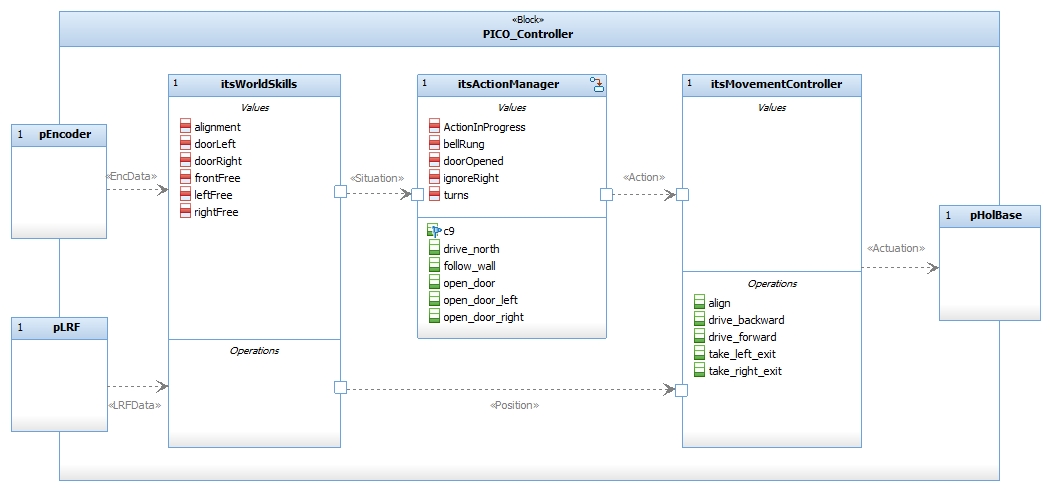
Internal flows
Finally, the information flows between the subsystems are specified. The incoming sensor data is gathered in the WorldSkills module, where it is converted to relevant information about the current situation and position of the robot. The situational information is then sent to the ActionManager, which will decide the upcoming action based on the situation (straight corridor / corner / T-junction etc.). The MovementController will then receive this command from the ActionManager and perform the manoeuvre using raw and processed position data provided by the WorldSkills. The diagram shows this flow of data through the system.
This diagram also shows various attributes and operations. These are elaborated in the subsystems' respective sections below.
World Skills
Filtering
To be able to process the laser data for detecting gaps, aligning or detecting doors, it is filtered first. Consecutive points have to be within a certain distance from each other, otherwise the points will be ignored. Furthermore, this filtering is used to look at a certain bundle of beams between two specified angles as shown in Figure WS1. Also the maximum length of a beam can be specified. When a point is within these boundaries it is considered as a valid point. This valid point is than stored as a coordinate.
Struct coordinate{
x double;
y double;
orig_r double;
orig_angle double;
}
|
 |
Alignment
Guiding PICO to the exit of a maze needs a proper alignment according to the walls. Since the obtained odometry data are not as precise as in the simulations, the robot is aligned after each 90 degrees turn that is made. Important to mention is that the first thing that PICO does when the controller software is started is aligning itself. This is done because the exact position and orientation of the robot in the maze is not known beforehand.
For determining the alignment with respect to walls of the maze, the laser beams of both the left- and right side of PICO are used. The ranges that are used for both sides are from 80 to 100 degrees on the left and from -80 to -100 degrees on the right with 2 meters the maximum length of the beams, as shown in Figure WS2.
Using the Pythagorean theorem, the corresponding distance ‘d’ is calculated for each of the laser beams in the range, using its angle and length. When these distances are determined, the difference between the mean distance of the beams in front of PICO and the ones behind PICO are divided. The sign of the value that comes out of this comparison indicates the direction in which PICO has to turn for proper aligning with respect to the walls of the maze. For example, when the compared value of the laser beams on the right side of PICO has a positive sign, the robot has to turn in positive direction. As clarification, Figure WS2 is added in which the example as explained before is pictured. Note that in this figure only the outer beams of the range are displayed for illustration.
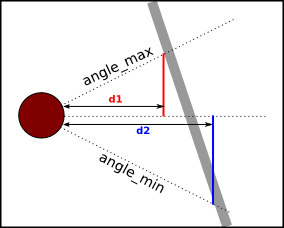
It can be the case that the robot is in an open space and only notices a wall on one side of the robot. Since PICO is able to align using only one wall, this is not a problem at all. In this case, the range of laser beams on the side where no wall is detected is neglected. The part of the designed controller that is responsible for the alignment of PICO can be found here.
The amount of alignment that is needed for driving through the maze safely, without bumping, is set to a fixed value that is tuned during the testing sessions. Below in Figure WS3 it is shown how PICO aligns between two walls of the maze.
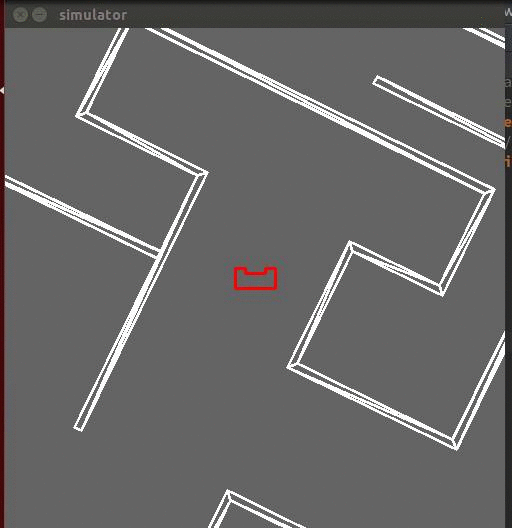
Side Free
One of the basic skills that is implemented in the code of the robot controller is detecting if a side is free or not. When a side is free, the algorithm as used in the action manager decides if PICO drives into the free direction or continues its path. For determining if the front of PICO is free, the beams within the range of -5 to 5 degrees are free. For the detection if one or both of the sides of PICO are free, the laser ranges from 110 to 120 degrees on the left and from -110 to -120 degrees on the right or the robot are used, as indicated in Figure WS1. For the detection of the free sides of the robot, a range of 0.9 meters is used. Laser beams with an angle or length outside the specified ranges will not be taken into account by PICO.
Door detection
Essential for finding the exit of the maze, a door located in a dead end of a corridor or in a wall has to be opened. In Figure WS4, a graphical representation of both these situations is shown. When PICO has detected a dead end, a bell will be rung and the door in the maze will be opened within a time of five seconds. Worth mentioning is that when PICO has opened a door in the maze, it will not ring a bell again when it reaches a dead end or detects a fake door in the side of the walls of the maze.
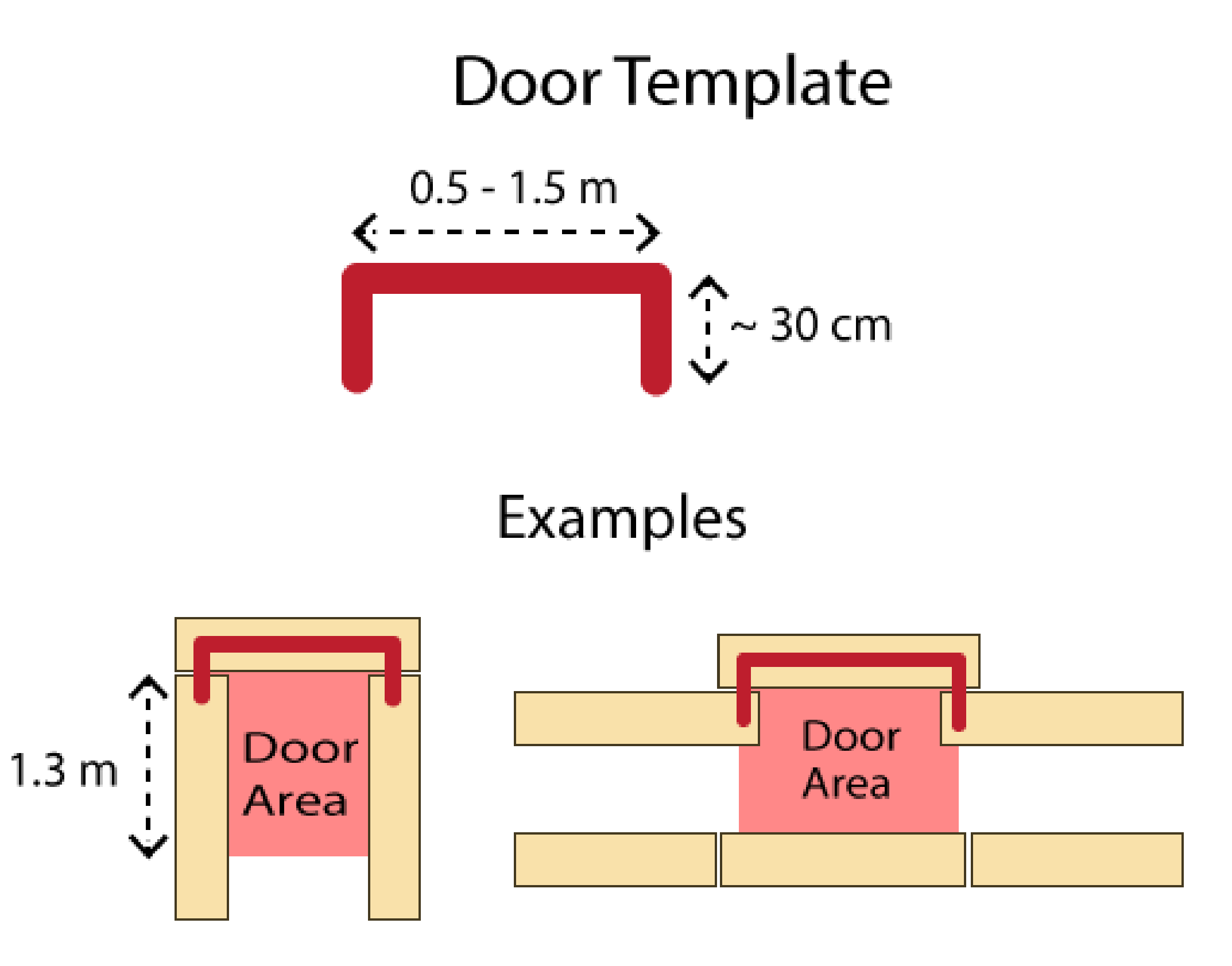
Front
PICO detects a door in the front by checking front free is negative and checking left and right free at angles 80 to 90 and -80 to -90 degrees respecitvely. When PICO has detected a door in the front and the bell is rung, the timestamp of the laser data corresponding to the moment where the dead end is detected is saved. This timestamp will be checked continuously until the before mentioned five seconds have expired. After these seconds, PICO will check if the front is free, indicating the door is open and the maze solving algorithm will continue. When PICO detects that the ‘door’ has not been opened and that the dead end is still a dead end, the algorithm will continue looking for a door.
Side doors
Next to a door that is located in a dead end, a door will be detected in the walls of the maze. This detection is implemented using laser data ranges on both sides of PICO. These ranges are from 15 to 120 degrees on the left of the robot and from -15 to -120 degrees on the right side with a range of 2.0 meters. Using the laser beams and the Pythagorean theorem as described in the Alignment section, distance ‘d’ is calculated for recognizing so-called vertical walls of the maze. A vertical wall is defined as the set of consecutive laser data points that have a value for ‘d’ within a certain uncertainty limits. When a distance ‘d’ is calculated that is not within these limits, PICO is recognizing a horizontal wall. For these horizontal walls, the same idea is applied as for the vertical walls, only now for determining distance ‘k’ using the laser beams and the Pythagorean theorem. In Figure WS5, a schematic overview of both the horizontal and vertical walls and distanced ‘d’ and ‘k’ is shown.
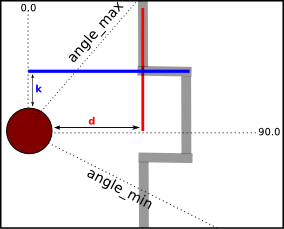
When PICO detects a horizontal wall after it is detecting a vertical wall, a corner is identified. This also counts when PICO detects a vertical wall after a horizontal wall. When four corners are detected at the same time, as shown in the figure above, a possible door is detected. For this detection of the four corners, a range of the length of the laser beams is set.
After detecting the four corners of a possible door at the side of PICO, it will continue driving forward until it recognizes two corners only. This means that corners X and X are out of range of the laser beams used for door detection and that PICO is positioned in front of the door.
After PICO has positioned itself in front of a possible door, a bell is rung and the same steps will be performed as for the front door detection. When PICO after five seconds recognizes the door has not been opened, and therefore is not a door, it will continue the maze solving algorithm. In the case where the door has been opened, PICO will notice the door no longer as a door but as a gap. Next, the maze solving algorithm will turn the robot towards the opened door, commands it to drive through it and continues solving the maze.
Unused functions
The functions as described below are not used in the final code for the maze challenge.
Wall detection
The first approach to process the laser data was to extract walls from it. This was done by looking at consecutive points who are close enough to each other to be the same wall. With this function we could detect separate walls when the distance between points were large enough as can be seen in Figure WS6. (Here every color is a set of points belonging to on wall.) This way of detecting walls neglects the corners as shown in Figure WS7. Therefore we tried to calculate the direction between two consecutive points to determine if it is one straight wall. The implementation of this part has never worked as it should. A reason could be that the noise between two consecutive points are to much at some point.
 |
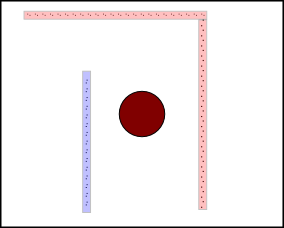 |
Corner detection
To identify the corners which could not be detected by the initial wall detection we implemented the following algorithm. Take a range of a certain amount of consecutive points. Draw an imaginary line between the first and the last point of the range shown in Figure WS8 by the blue line. Calculate for each point in between the lateral distance to the imaginary line. When the distances are below a threshold there is no corner in this piece of wall. When there is at least one distance larger than the threshold it is a corner. If there are more than one larger distances the furthest point is the corner point, this is represented in Figure WS8 by the red arrow. When there is no corner detected in the current range the range is shifted one point further. When a corner was detected the next range begins with the corner point. This approach seemed to work for some corners, but the corner points were too unstable. Sometimes it did not see corners when PICO was really close to the corner. We tried to tune the algorithm but in the end we stopped using it.
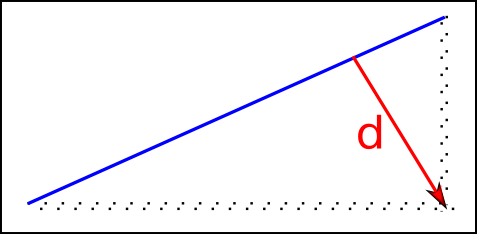
Movement Controller
The movement controller has the purpose of drive PICO according to the Action Manager decisions without bumping into any wall or obstacle through the way.
Potential Field
In order to move PICO through the maze avoiding the walls and towards the exit, potential field is used which is a type of behavior-based robotics. These actions or behaviors most of the time are stimulus-responses, a reaction to some world stimulus (walls/obstacles) and generates an action in response of this stimulus (stop, move right, move left, etc.). Potential field consist of a resulting force/vector, obtained after attractive and repulsive forces are taking into consideration, which corresponds to the speed and desired angle of the movement desired for PICO. Obstacles and walls have a repelling force, while the set point gives an attracting force. The repulsive forces are computed for every laser point available using equation below and decomposed into [math]\displaystyle{ x }[/math] and [math]\displaystyle{ y }[/math] components using its respective angle. For the attraction force, only the set point is considered, in our case, the attraction force is always the same given the fact that potential field is not being used to make the rotation movement, e.g.set point is the same all the time.

where [math]\displaystyle{ b }[/math] is a gain constant used to tune the behavior of PICO. For this particularly constant, the tuning had to be made with real PICO as the simulation and reality were really different for this tuning. Finally the resulting components in [math]\displaystyle{ x }[/math] and [math]\displaystyle{ y }[/math] are saturated within the physical or permitted limits. The designed potential field function can be found here.

Rotations
The specifications for the maze challenge specify that within the maze only walls are approximately axis-aligned, meaning there are only right angles (or 180). For making the 90 and 180 degrees turn, odometer data is used, howver presents some error to make this turns and if it’s not considered PICO will end up accumulating this error at every turn (error is solved with the alignment function see 3.4.2). The main idea is that when Action Manager determines that a turn either right, left or turn around must be performed PICO stops and the odometer data is captured (doesn’t matter the original value), then the angular velocity is given to PICO starting the rotation, the new odometer data is checked at every instant and compared with original position until the rotated angle is 90 degrees.
Unused functions
Variable Setpoint
After potential field was working, one idea was to use it to make the turning by using the angular velocity and changing the set point in the middle of the corridor either right or left, or behind PICO for a 180° degree and the potential field automatically will go in that direction avoiding walls. This function was not used because at the moment result really time consuming to compute the variable set points and also because as we only would need 90° turns, it would be enough with the odometer data.
Virtual Corridor
When implementing the motion control, we found out that while driving forward, PICO move away of the wall when driving through open spaces because of the potential field when computing the resulting force, the "free" space was more attractive than keep going forward leading to miss some turns in some cases, one solution to avoid this was the "Virtual Corridor" function, the idea is that when PICO was in open spaces, we make PICO think he is in a corridor by adding some "virtual walls" instead of the open space so PICO will keep a straight forward direction. Even when the implementation worked on simulation, it was only possible to try it once in the real world with not sufficient time (tuning was needed) so this idea was abandoned as it didn't work at first try.
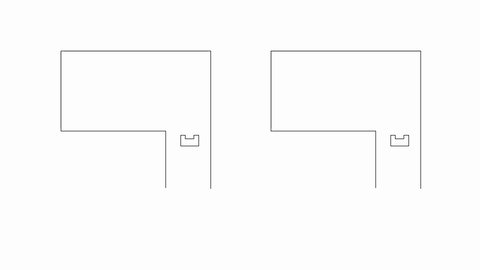
Action Manager
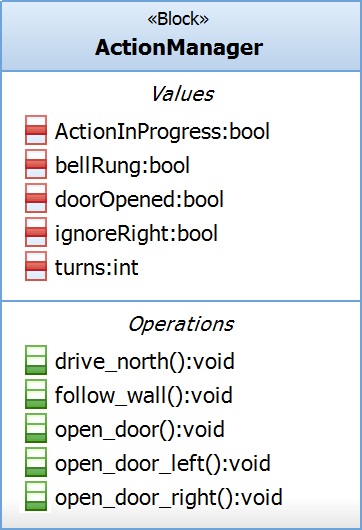
The action manager’s purpose is to decide which action to perform depending on the situation (see Figure IBD). It will do so with the concept of the Pledge algorithm, which was explained earlier (ref!!!!!!!!!!!!!!!!!!!!!!!!!). It has been arbitrary chosen that within this algorithm a right hand wall follower is used. Figure AM1 shows that the module utilizes five attributes and five operations (states) in its behaviour.
Attributes
Besides the input from the WorldSkills, the following five attributes are utilized:
ActionInProgress
A boolean which indicates whether or not an action is currently being executed by the movement controller. This is implemented as a safeguard to prevent the action manager from issuing new commands to the movement controller while it is still performing an action like taking a turn. This boolean is reset to true by the movement controller when it has finished its maneuver.
if(!actionInProgress)
{
- …
- else if(leftFree)
- {
- stateMove = take_left_exit;
- actionInProgress=true;
- …
- }
…
}
bellRung
A boolean to store whether or not the bell to request the opening of a door has been rung. This is necessary to make sure PICO rings only once, instead of in every cycle:
if(!bellRung)
{
- io.sendOpendoorRequest();
- bellRung=true;
}
doorOpened
A boolean that keeps track of whether or not a door has been opened already. As it is stated that there is only one door present in the maze, it would be a waste of time trying to open a second potential door. This attribute is used in many conditions considering door detection and state changes. All of these states become unavailable if the boolean is set to true.
if(doorLeft && !doorOpened)
{
- statePledge=open_door_left;
- …
}
ignoreRight

A boolean that prevents PICO from turning back at a junction. Because a right hand wall follower is used, turning towards a right gap is preferred over moving forward. This leads to the following behavior: PICO
- detects a gap to its right,
- turns towards the gap,
- detects a gap to its right (corridor it just came from) and
- PICO turns back towards the corridor.
The attribute prevents this behavior by disabling turning right twice in a row. This functionality is illustrated in Figure AM2.
else if(rightFree&&!ignoreRight)
{
- stateMove = take_right_exit;
- ignoreRight=true;
- …
}
Turns
This integer is vital for the functionality of the Pledge algorithm. It indicates PICO’s orientation relative to the initial north heading. For every right turn, a value of 1 will be added and for every left turn, 1 will be subtracted. This means that when the value is either 2 or -2, PICO is oriented in the exact opposite direction (180 degrees) as it was initially. It is also important that the value of the integer is not limited in both positive and negative direction, even though PICO will be oriented in the same direction for values of 0, 4, 8, -4, -8…
else if(leftFree)
{
- stateMove = take_left_exit;
- turns--;
- …
}
States
The action manager uses a state machine to switch between five states:
- Drive north
- Follow wall
- Open door left
- Open door right
- Open door front
Drive north and Follow wall are the two states that are used by the pledge algorithm and control PICO’s movement through the maze. The three Open door states are only accessed when a possible door is detected and are always followed up by either Drive north or Follow wall. A state machine diagram, depicting this behavior is shown ………:
< main statechart >
Testing sessions
This section describes the progress made during the testing sessions. A general outline of the process is given, followed by a more detailed report per session.
Phase 1: Pre-corridor challenge
During this phase of the project the main objective for PICO was to:
- drive forward with stability,
- detect a perpendicular corridor to its left or right and
- turn towards this exit and continue forward.
It turned out that keeping PICO from bumping into the maze’s walls could be achieved relatively easy by the use of the potential fields. More issues were encountered in making PICO detect the side gaps and making him stop approximately in the center of the junction. Initially, an algorithm was used that would give a trigger the instant that a gap is detected, which happened tens of centimeters before the actual junction [REF]. After adapting the algorithm to only use a part of the LRF’s range and iteratively tuning its parameters, PICO was able to stop before the center of the exit [REF].
When the corner had been detected, PICO was commanded to turn 90 degrees to the left or right. This maneuver, however, turned out to be more difficult than expected; It seemed that PICO’s rotated angle could range between approximately 70 and 110 degrees, when the movement was based on the odometry data [REF]. This kind of misalignments would cause PICO to crash into the side walls, hence different approaches were tried. Finally, an algorithm that would make PICO start rotating on command and stop rotating when it detects that the beams in front of him read a minimum distance, seemed the most suitable in simulation.
The code for the action manager was fairly simple, as its only job was to give the turn left or right command depending on where the gap was detected. No problems or struggles occurred during any test session with this module.
Phase 2: Pre-maze challenge
Corridor Challenge
Plan & Expectations
The strategy for the corridor challenge was to drive forward as fast as possible with potential field as controller to keep PICO in the middle of the corridor. While driving through the corridor the sides are continuously checked for gaps using ranges of laser data to the left and right of PICO. These ranges are tuned during experiment sessions. When a gap is detected PICO stops for a moment and has to turn 90 degrees to the side of the gap.
The initial idea was to use the odometry data for this purpose, but from testing results it seemed that this data was not reliable enough to let PICO turn. For this reason it is chosen to implement turning that is based on time delay using a for loop (see below) and that PICO would be stopped as soon as he detected that his front was clear, facing the exit corridor. The amount of iterations is also tuned in simulation. When the turn is completed PICO will drive forward again as we did before the turn. In Figure CC1, the simulation of PICO driving through the corridor, finding an exit and exiting it is shown.
Pico start turning
For x iterations (where x is around 25000)
Keep turning
Pico stop turning
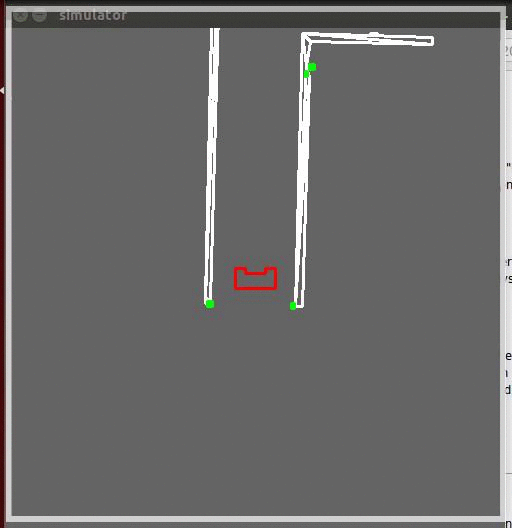
Results & Discussion
During the corridor challenge driving forward controlled with the potential field worked as we expected. There were some minor side movements which could be tuned for the future, but overall the potential field worked fine. The gap was detected and also at the right time, that is when PICO was standing in front of the gap. PICO stops and started turning, but it never stopped turning during the corridor challenge.
This failure was caused by the for-loop delay, the time PICO had to turn. This delay was tuned in the simulator, but on PICO it did not work as simulated. We learned that PICO does not behave exactly as in the simulator, and that a for loop delay is based on CPU time, which is depending on the computer or state of the computer. Also turning based on a delay is not as robust as using the sensor data. For the maze challenge we have to improve the turning. It was concluded to take out the time-based events and abandon their use for the remainder of the project.
|
Recording of the corridor challenge
|
Testing of the code after the corridor challenge
|
Maze Challenge
Plan & Expectations
PICO was expected to drive based on the pledge algorithm with a right hand wall follower, continuously looking for possible doors. When PICO found a door that opens, it will stop checking for doors because there can only be one door opened. Also the initial direction of the pledge algorithm is reset to the direction of the opened door. Because of the implemented algorithm PICO should always exit the maze. The time PICO will take to find the exit depends on the layout of the maze.
It is expected that PICO will drive relatively fast towards the exit of the maze without bumping into walls, because of the high speed and tuned potential field parameters. After every turn PICO makes it will be aligned to the near walls at the sides of the robot. Below a video is presented of the simulation when PICO drives to the maze of the maze challenge.
Simulation of the maze challenge
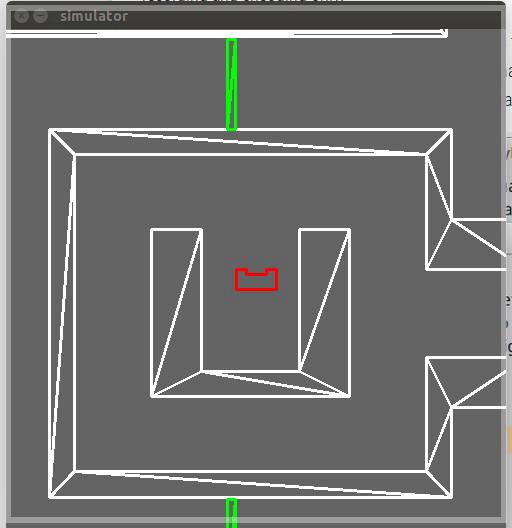
Results & Discussion
During the maze challenge PICO was executing the implemented Pledge algorithm with a right hand follower. It was also checking for doors in the walls of the maze continuously. As can be seen in the video of the top view of the maze challenge below, PICO finds a door and rings a bell so that this door opens. After this door has been opened, PICO defines its driving direction as the initial direction. When the robot bumps into a wall, the right wall follower is engaged and PICO starts following this wall. Unfortunately, PICO got stuck in a deadlock situation and therefore was not able to exit the maze. A recording of both attempts when PICO tried to find the exit of the maze are shown in the video below.
Recording of the maze challenge
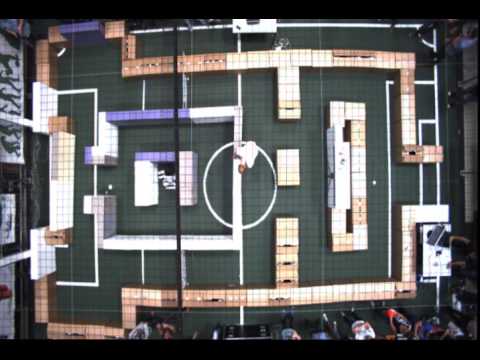
For defining the problem that occurred in the situation in the real maze during the challenge, both the simulation video as shown above and the recorded video of the maze challenge are analyzed. An extensive description of the these videos with PICOs actions can be found on the maze simulation page for the simulation and on the maze recording page for the recording, which are listed with according time stamps. From the analysis of both videos, it can be concluded that there are a number of differences in the behaviour of PICO.
In the beginning of the simulation PICO detects a fake door, but does not recognize it in the maze challenge.
When PICO has found its way out of the inner space, PICO turns right in the simulation and left during the maze challenge for both attempts.
Furthermore, PICO gets in a deadlock state when it almost has reached the exit of the maze. This makes the robot decide to go back into the maze and repeats this several times until it is stopped by the user. During the second attempt the same happens twice, after which PICO gets out of the deadlock state and continues its way. Unfortunately, the challenge is stopped due to time limits.
Meetings Overview
Brief summaries on the contents of team meetings are available here: [1]
